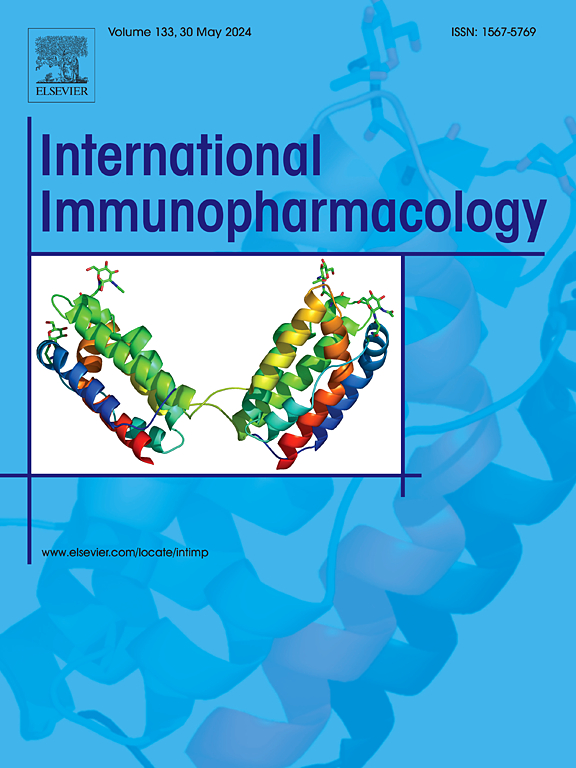金丝桃苷通过TRX1/NLRP1/Caspase-1信号通路介导小胶质细胞极化和神经炎症,缓解社交失败小鼠抑郁样行为。
IF 4.7
2区 医学
Q2 IMMUNOLOGY
引用次数: 0
摘要
本研究的主要目的是探讨金丝桃苷(Hyp)提取物对慢性社会失败应激(CSDS)诱导的小鼠抑郁样行为的潜在药理作用。此外,我们利用腺相关病毒(adeno-associated virus, AAV)和BV2小胶质细胞评估了TRX1/NLRP1/Caspase-1信号通路中神经炎症因子的变化。TRX1蛋白和BDNF的表达水平也因Hyp而升高,而NLRP1和Caspase-1的表达水平则显著降低。此外,在小胶质细胞炎症模型中发现Hyp抑制TRX1泛素化。体内和体外实验均发现,Hyp可显著促进海马小胶质细胞向M2表型极化,减轻神经炎症,从而改善CSDS小鼠的抑郁样行为。这与TRX1泛素化的调控有关,这抑制了NLRP1和Caspase-1蛋白的表达水平。本文章由计算机程序翻译,如有差异,请以英文原文为准。

Hyperoside alleviates depressive-like behavior in social defeat mice by mediating microglial polarization and neuroinflammation via TRX1/NLRP1/Caspase-1 signal pathway
The primary objective of this study was to investigate the potential pharmacological effects of Hyperoside (Hyp) extract on chronic social defeat stress (CSDS)-induced depression-like behavior in mice. We established CSDS mice to evaluate the antidepressant effects of Hyp. Additionally, We assessed the changes in neuroinflammatory factors in the TRX1/NLRP1/Caspase-1 signaling pathway using adeno-associated virus (AAV) and BV2 microglial cells. The expression levels of TRX1 protein and BDNF also increased by Hyp, while NLRP1 and Caspase-1 a significant decrease. Additionally, Hyp was found to inhibit TRX1 ubiquitination in the microglial inflammation model. In both in vivo and in vitro experiments, it was found that Hyp significantly promotes microglial polarization towards the M2 phenotype in the hippocampus and alleviates neuroinflammation, thereby improving depression-like behavior in CSDS mice. This is associated with the regulation of TRX1 ubiquitination, which inhibits the expression levels of NLRP1 and Caspase-1 proteins.
求助全文
通过发布文献求助,成功后即可免费获取论文全文。
去求助
来源期刊
CiteScore
8.40
自引率
3.60%
发文量
935
审稿时长
53 days
期刊介绍:
International Immunopharmacology is the primary vehicle for the publication of original research papers pertinent to the overlapping areas of immunology, pharmacology, cytokine biology, immunotherapy, immunopathology and immunotoxicology. Review articles that encompass these subjects are also welcome.
The subject material appropriate for submission includes:
• Clinical studies employing immunotherapy of any type including the use of: bacterial and chemical agents; thymic hormones, interferon, lymphokines, etc., in transplantation and diseases such as cancer, immunodeficiency, chronic infection and allergic, inflammatory or autoimmune disorders.
• Studies on the mechanisms of action of these agents for specific parameters of immune competence as well as the overall clinical state.
• Pre-clinical animal studies and in vitro studies on mechanisms of action with immunopotentiators, immunomodulators, immunoadjuvants and other pharmacological agents active on cells participating in immune or allergic responses.
• Pharmacological compounds, microbial products and toxicological agents that affect the lymphoid system, and their mechanisms of action.
• Agents that activate genes or modify transcription and translation within the immune response.
• Substances activated, generated, or released through immunologic or related pathways that are pharmacologically active.
• Production, function and regulation of cytokines and their receptors.
• Classical pharmacological studies on the effects of chemokines and bioactive factors released during immunological reactions.

 求助内容:
求助内容: 应助结果提醒方式:
应助结果提醒方式:


